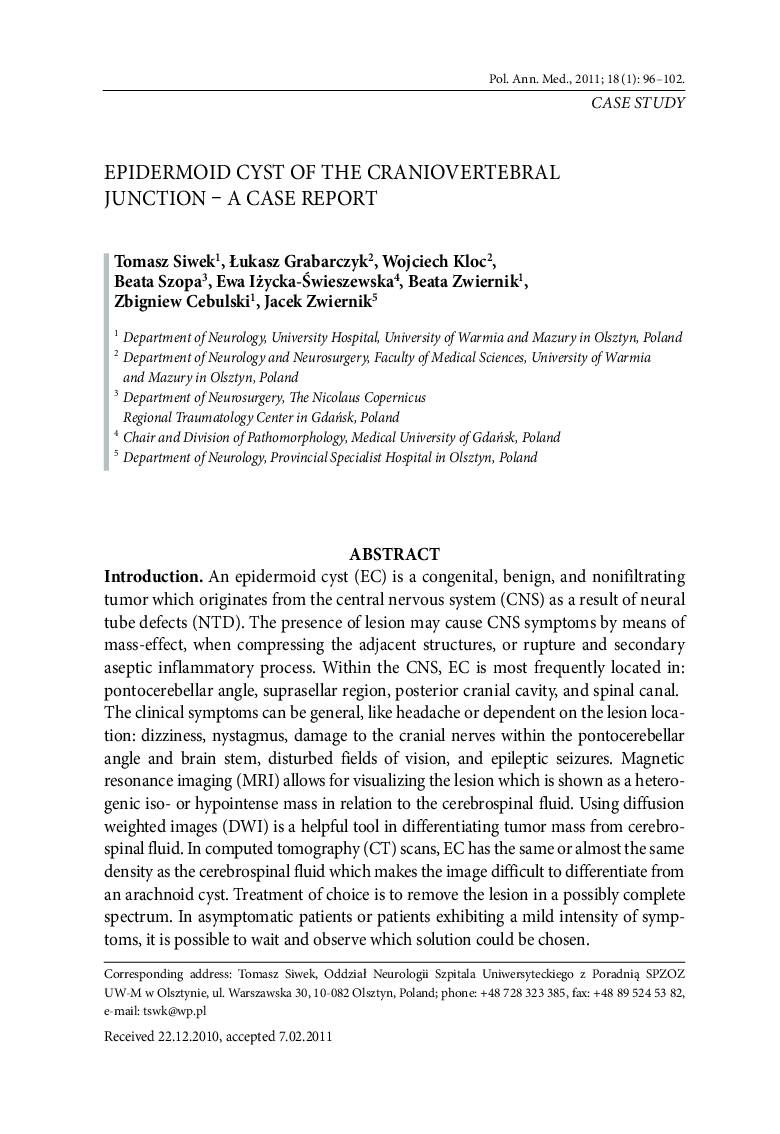| کد مقاله | کد نشریه | سال انتشار | مقاله انگلیسی | نسخه تمام متن |
|---|---|---|---|---|
| 2676026 | 1564459 | 2011 | 7 صفحه PDF | دانلود رایگان |

IntroductionAn epidermoid cyst (EC) is a congenital, benign, and nonifiltrating tumor which originates from the central nervous system (CNS) as a result of neural tube defects (NTD). The presence of lesion may cause CNS symptoms by means of mass-effect, when compressing the adjacent structures, or rupture and secondary aseptic inflammatory process. Within the CNS, EC is most frequently located in: pontocerebellar angle, suprasellar region, posterior cranial cavity, and spinal canal. The clinical symptoms can be general, like headache or dependent on the lesion location: dizziness, nystagmus, damage to the cranial nerves within the pontocerebellar angle and brain stem, disturbed fields of vision, and epileptic seizures. Magnetic resonance imaging (MRI) allows for visualizing the lesion which is shown as a heterogenic iso- or hypointense mass in relation to the cerebrospinal fluid. Using diffusion weighted images (DWI) is a helpful tool in differentiating tumor mass from cerebrospinal fluid. In computed tomography (CT) scans, EC has the same or almost the same density as the cerebrospinal fluid which makes the image difficult to differentiate from an arachnoid cyst. Treatment of choice is to remove the lesion in a possibly complete spectrum. In asymptomatic patients or patients exhibiting a mild intensity of symp, it is possible to wait and observe which solution could be chosen.AimThe aim of this paper was to present a case report concerning treatment of an EC located in the craniovertebral junction.Materials and MethodsA clinical management concerning a patient diagnosed and treated both in an outpatient clinic and in hospital at the departments of neurology and neurosurgery has been described.Case studyA 69-year old female patient came to the Neurology Outpatient Clinic complaining of headaches, pain in her neck, and balance disturbances. These symptoms had intensified for 2 years. An MRI scan of the cervical spine revealed a large lesion in the posterior cranial cavity. An MRI scan of the head showed a multicystic tumor located in the posterior fossa in the projection of cerebellomedullary cistern, which did not undergo contrast intensification. The patient was treated surgically. Following surgery, headaches, pain in the neck as well as neurological symptoms subsided.Results and discussionMicrosurgical removal of the lesion is the treatment of choice for EC. A total removal should be strived for, preferably en block, although leaving part of the cyst is not a mistake. Postoperative mortality may reach 8.9%, whereas recurrences amount to 4.5% during an 8-year long observation period. EC untreated surgically can, through dermal fistulas, cause bacterial meningitis. Thus, treatment limited to the observation of the lesions may pose a threat, and surgical treatment should be decided upon quickly.ConclusionsSurgical treatment with the use of microscopic technique aided with neuromonitoring allows for removing tumors of the cholesteatoma type safely and radically.
Journal: Polish Annals of Medicine - Volume 18, Issue 1, 2011, Pages 96–102